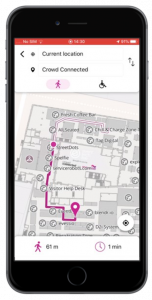

The change in the value chain is really exciting and continues to keep us on our toes as we strive to serve our customers and distribution partners. It spurs us to constantly innovate and find solutions that best solve our customers’ problems. For example, there is a lot of interest in mobile mapping and laser scanning solutions as regions of the world rebuild their crumbling infrastructure and invest in new infrastructure, such as telecommunications. Over the years, we have put a heavy focus on data capturing technology and software to support the various uses of the data, be it feature extraction or analytics.
We are also seeing a rapid evolution in sensor integration and a migration of workflows to the cloud. In the past, survey and mapping professionals would capture information and then hand it over to one or multiple users. With cloud-enabled workflows, our customers have instant access to data and can easily share project information with multiple stakeholders, making edits and approvals easier. This is exciting for us. We want to help our customers embrace and be out in front of these changes.
Within Trimble Geospatial, our core mission is providing solutions to help our customers connect the physical earth to the digital world. This is what underpins everything we do. And this works very well in a broader context in a company like Trimble, as we work with multiple industries. I actually view survey and mapping professionals as a sort of on-ramp to these industry workflows. In construction, for example, you capture topographic information before you redesign a bridge, or go out and do scanning to capture the as-built. The entire time, personnel in the field and office are operating in a fully connected environment, which minimizes downtime caused by information requests and design and stakeout updates. And then, when you need to bring that data back out through machine control, it flows back out into the field. Survey and mapping professionals are very much an on-ramp into that industry workflow.
The same thing happens in utilities. Our utilities customers are capturing information about their critical infrastructure, feeding that into the utilities workflow, and then eventually going back out and inspecting and maintaining that information. Putting that into the context of Trimble, we have a visual concept. I think of Trimble Geospatial as the center of a compass. The four cardinal points are the big industry workflows, which align with Trimble. A true north for us is Engineering and Construction. If you look to the east, there are Pipelines and Petroleum, and south is Land Administration — our backbone — and then the west is Utilities, where our infrastructure continues to evolve. Then you start getting into so many other industries in which we are working, such as conservation, mining and education. These are the key markets for us. So, if you go back to that compass visualization, geospatial is actually placed at the center of the company. It’s at the beginning of a process, when you need to determine what the physical earth looks like and report on the site condition changes.
I actually see it as an ecosystem. For Trimble Geospatial, hardware is a very important component of that ecosystem, as are our software, cloud services and correction services. Our distribution partners are a part of that ecosystem. So, on a Friday evening if you have a critical railway surveying project, our distribution partners will be there to get you the gear you need to work on the weekend. If you think about it, the ecosystem does not work without all of those pieces working together.
Trimble Business Center is the linchpin of our survey and mapping ecosystem, the hub where all of the surveying data goes. Over the years, we have taken the key functionality from RealWorks, Inpho and eCognition and made it part of Trimble Business Center so our customers can standardize on a single package and reduce training and operational costs. We have still kept these packages as standalone offerings as we share the key technology engines in our efforts to connect and scale. Industry professionals process the data and generate deliverables for their clients, who in turn share it with their downstream customers. One of the most important things for Trimble Geospatial and our customers is that we have interoperability with the downstream users of that data — they may be Autodesk customers, Bentley customers or Esri customers. Trimble Business Center is that critical link between our field solutions and those downstream users.
In the future, the Trimble Business Center, which is a standalone software, may look different for different companies, as we look to increase productivity for our customers by leveraging cloud services. The key for Trimble Business Center will be to provide customers what they need, when they need it. For instance, if a company does a lot of airborne processing at a certain time of the year, that is when they may want a license for our survey photogrammetry solution. It is about the software evolving to better fit the needs of customers.
Today, there is a lot of focus on improving the infrastructure around the world. Capturing the earth and converting it into a digital model or a Digital Twin will play a very important role in improving our roads, bridges, ports, railways and airports
The Digital Twin is a relatively new concept. Since Trimble began working in surveying and mapping, our customers have been connecting the physical earth with the digital model, which is another way of stating a Digital Twin. Today, there is a lot of focus on improving the infrastructure around the world. In the US, Congress is debating how many billions and trillions of dollars are required to improve the infrastructure. In Europe, a lot of stimulus money is being poured into infrastructure improvement. Capturing the earth and converting it into a digital model or a Digital Twin will play a very important role in improving our roads, bridges, ports, railways and airports. Before you improve or maintain any of this infrastructure, you must know its current condition; only then will you be able to monitor the change. Geospatial plays an incredibly important role in the Digital Twin, as we are out there capturing the digital replica. Our customers, surveyors and geospatial professionals in the field are the ones standing in front of that bridge for which there would be a Digital Twin, so that designers, engineers and planners can work on improving that infrastructure.
Changes in data collection and processing have helped us broaden our role beyond simply capturing information in the field. It’s about how we allow better visualization of that data, how we improve the fidelity of data, the meta information of that data. That’s where the cloud is actually well positioned. These changes have also allowed us to think of that concept of the ecosystem in which all of those elements have to be in harmony for our customers to be able to get their work done in 2021. This is very different from the way things were in 1996, when I started working with Trimble.
There are numerous places in the field-to-fork workflow where geospatial technology plays an incredible part
Positioning, Navigation and Timing technology is critical. Today, the Global Navigation Satellite System (GNSS) is everywhere — it’s in our phones, cars, and is critical to the ecosystem that I mentioned earlier. Trimble was one of the pioneers in the development of commercial and consumer applications of the Global Positioning System (GPS) technology. We have been very focused from day one in making the PNT infrastructure resilient. There is a lot of internal development that we are doing to make the system stronger. We are also working with government agencies to prepare them for how they might continue their operations in a situation where there is a localized outage of PNT. We are working very hard for our customers to have continuity of operations.
There are so many places in the field-to-fork workflow where geospatial technology plays an incredible part. It actually brings all the elements of the geospatial ecosystem together — from satellite and Earth Observation companies providing field information to the solutions designed by analytics companies that can be used by experts in the field. That information from satellites or drones adds to the domain knowledge of the farmer. On the field, we have Trimble solutions on spraying and fertilizing equipment that are improving crop performance while reducing fertilizer use. This enables farmers to increase farm efficiency and sustainability while lower costs and emissions. Once the crop has been harvested there is geospatial technology to support the logistics of getting fresh food to the table.
Today, there is a big move towards autonomy, and most of the manufacturers are working on what those solutions will look like 10-20 years down the road. There are definitely geospatial components in that. For instance, correction services are very important for providing high-precision positioning technology. Also, our mobile mapping systems are being employed quite frequently to provide the source of truth. So, if you want to be able to test an autonomous vehicle, it’s important to have a highly accurate base map. Finally, some combination of sensors, be it LiDAR, radar or GNSS, will be part of autonomous solutions of the future. When I say autonomous, it does not only mean cars and taxis; it’s also going to be construction and agriculture equipment. Personally, I feel it will happen in construction and agriculture before it comes to cars, because it will depend on where they operate or how they can be safely operated in fields, at construction sites and in mines.
In 2020, our customers, distribution partners and employees were all incredibly resilient in one of the most challenging periods I have ever seen in my career. All three stakeholders kept operating and stayed focused on their role in the global economy.
There was massive change in where people were living and decided to live. In the United States, we saw a very large focus on single-family and multi-family construction, and our surveying customers were very busy serving the needs of that residential construction market. As people decided to move to new areas or work from home, it required a lot of new homes to be built, and we still haven’t yet caught up with the demand for that. We are still in the middle of that very big residential construction boom. The second thing that happened was that governments put funds into infrastructure construction and maintenance, and that caused our customers to be incredibly busy — capturing that physical information, the as-built of current infrastructure.
You spoke about the geospatial industry evolving rapidly, and that is the thing that excites me about working at Trimble and in the industry. I just love that rapid evolution. It keeps us fresh and keeps me wanting to get up every morning and get into the office. I think our strength lies in our connection to our customers and our ability to understand how their needs are changing and evolve our innovation to meet those needs. We were doing that back when I first joined in 1996, and we will be doing that well after I have moved on.
The changing needs of our customers mostly concern interoperability between multiple stakeholders and the requirements around data capturing. When I first started, surveyors used either optical instruments or GNSS. Now, increasingly, surveying companies need to have experience in a number of other technologies like scanning, UAVs and ground penetrating radar. They need to have a deeper understanding of the data and where it is going to be used. All these changes have happened in the last few years, and we have embraced them to help our customers.


© Geospatial Media and Communications. All Rights Reserved.